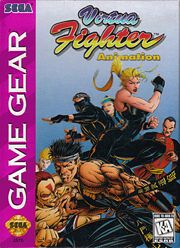Virtua Fighter Animation
This article needs additional citations for verification. (June 2007) |
| Virtua Fighter Animation | |
|---|---|
 Game Gear cover art | |
| Developer(s) | Aspect Co. |
| Publisher(s) | Sega |
| Designer(s) | Yasuhiro Nishimoto (Producer[1]) Teruo Hamai (Chief designer[1]) |
| Composer(s) | Kojiro Mikusa[1] |
| Series | Virtua Fighter |
| Platform(s) | Sega Game Gear Sega Master System |
| Release | Game Gear Master System |
| Genre(s) | Versus Fighting |
| Mode(s) | Single player |
Virtua Fighter Animation, known in Japan as Virtua Fighter Mini (バーチャファイターMini, Bācha Faitā Mini), is a 1996 versus fighting video game for the Sega Game Gear and Sega Master System. It is based on the Virtua Fighter anime series.
Gameplay
The main mode of gameplay is a story mode, which shows cut scenes between stages. Unusually for a Virtua Fighter game, this meant a restricted choice of characters, as each one is unlocked after being beaten in the story. Virtua Fighter Animation offers three viewing modes: Normal, Large, and Realtime. Realtime was an effort to recreate the zooming camera effects of the 3D Virtua Fighter games, by swapping between small and large sprites to represent distance.
Characters
Despite their appearances in the anime, Jeffry McWild, Shun Di and Lion Rafale were not included in this game.
Version differences

In Japan, Virtua Fighter Mini was marketed as part of the rebranding of the Game Gear to "Kid's Gear". It has a multiplayer mode missing from other releases, as the game was included as part of a special bundle containing a Game Gear with Virtua Fighter artwork and a link cable. It also contains an extended introduction sequence based on the opening of the anime series. Also exclusive in the Japanese version is a voice sample of Akira Yuki at the end of story mode before the credits roll, as well as his and other characters' voice samples as victory quotes in VS. Mode.
To make it more marketable outside Japan, some parts of the English script were changed from the Japanese version's by making it a little comedic instead of seriously faithful to the original Japanese version of the anime's script. The Sega Master System version of Virtua Fighter Animation was only released in Brazil, where it was produced officially by Tec Toy. It is identical to the Sega Game Gear version, except it lacks the viewing modes of it, and uses the English script from the international releases.
A Sega Genesis version of Virtua Fighter Animation was also in development,[2][3] and scheduled for release in 1997 in North America. However, it was canceled for unknown reasons.
References
- ^ a b c Closing credits of Virtua Fighter Animation. Retrieved on 04-16-2010.
- ^ "16-Bit Gets Sonic and Virtua Fighter". Sega Saturn Magazine. No. 9. Emap International Limited. July 1996. p. 15.
- ^ "E3: Virtua Fighter Animation". GamePro. No. 95. IDG. August 1996. p. 52.
